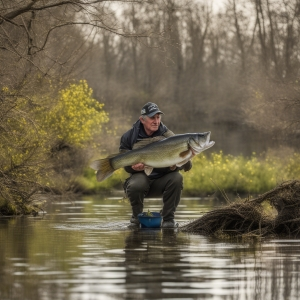Table of Contents:
Introduction to Springtime Bass Fishing
Spring is an excellent season for bass fishing. As winter lifts its biting chill and nature begins to bloom, bass too shake off their winter sluggishness, making the waters a hub for some high-octane fishing action. Novices and seasoned anglers alike anxiously await this season's bounty, armed with an array of fishing equipment and driven by hopes of reeling in a trophy catch. This brief primer on springtime bass fishing aims to help you understand the distinctive conditions and patterns of this season. Furthermore, it offers practical advice to help you navigate and master the art of spring bass fishing with valuable techniques and strategies. By putting these into practice, you can increase your chances of success on your next fishing sojourn.
Understanding Bass Behaviour in Spring
For successful springtime bass fishing, understanding bass behaviour is crucial during this period of change. As water temperatures increase, the metabolism of bass gets boosted up, leading them to search for food more actively. At this time, they generally move towards shallower waters, making it easier for you to spot an opportunity. Furthermore, spring marks the beginning of the bass spawning season, which can significantly impact their feeding habits and behaviours. Learning these behaviours can help you to predict their movements, identify potential fishing locations and ultimately maximise your chances of making a successful catch.
Pros and Cons of Springtime Bass Fishing Techniques
| Techniques | Pros | Cons |
|---|---|---|
| Topwater Fishing | Highly thrilling, Can provide big catches in the right conditions | Not suitable in windy conditions, Requires good casting skills |
| Jigging | Can be used in any depth of water, Effective in winter and spring | Takes time to master, Can be tiring |
| Shallow Cranking | Good for covering large areas, Can catch bass in a variety of depths | Not effective in very deep water, Requires a lot of rod and reel preparation |
| Drop Shotting | Very effective in catching finicky bass, Can be used year-round | Not suitable for fishing in heavy cover, Requires high-quality line and knot |
Essential Gear for Spring Bass Fishing

When it comes to gear up for spring bass fishing, it's all about selection. With the season's variable conditions, it's important to have a diverse set of tools at your disposal. Here's a look at some critical items you should add to your fishing kit.
First, consider the factors impacting the choice of your fishing rod. The right balance, sensitivity, and length can have a significant impact on your casting accuracy and distance. A medium-to-heavy rod, ideally between 6.5 to 8 feet in length, is generally recommended.
Next, let's talk about fishing lines. Monofilament, fluorocarbon, or braided fishing lines, have their merits. However, fluorocarbon lines are gaining popularity owing to their lower visibility in water and higher sensitivity.
Your choice of tackle will be dictated by bass behaviour and the prevailing water conditions. A combination of spinnerbaits, lipless crankbaits, topwaters, and soft plastics can cover a wide range of fishing situations you may encounter in spring.
Last, but certainly not least, is your choice of fishing hooks. Size, style, and sharpness can dramatically alter your chances of successfully hooking and landing a bass. A well-curated assortment of hooks will ensure you're ready for the diverse challenges spring bass fishing presents.
Ultimately, your spring bass fishing gear should reflect a blend of versatility and specificity.
Useful Techniques for Catching Bass in Spring
Learning sound and successful techniques can significantly ramp up productivity while fishing for bass in spring. It's a good idea to keep some of these techniques in your angling playbook even if conditions may differ.
Slow Rolling Spinnerbaits: In the early spring, when bass are still fairly lethargic, slow rolling spinnerbaits near their hideouts can generate strikes. Cast the bait deep and reel it back slowly, just enough to keep the blades spinning.
Flick and Flutter: Soft plastic worms or minnows can be extremely effective in spring. The trick lies in the presentation. Cast it out, let it sink, and then flick the tip of your rod to mimic an injured prey, one of the bass's favorite meals.
Lipless Crankbaits: Perfect for covering a large area, lipless crankbaits can be fished at different depths. You can burn them across shallow flats or yo-yo them off the bottom. Vary your retrieve until you find what works.
Topwater Tactics: As spring advances and water temperatures continue to rise, bass begin to feed closer to the surface, and topwater presentations can lead to explosive strikes. Floaters and poppers are a couple of effective topwater options.
To summarise, effective springtime bass fishing requires an adaptive approach that shifts with the changing seasonal conditions. Being flexible and willing to experiment with different techniques greatly enhances the springtime bass fishing experience and the chance for that trophy catch.
Bait Selection for Springtime Bass

Identifying the appropriate bait forms a crucial part of the strategy for successful springtime bass fishing. In spring, bass are keener to feed, primed by the change in temperatures. Your choice of bait should reflect this behaviour change. Bass feed on a variety of different species at this time of year, meaning that a versatile approach in your bait selection could prove beneficial.
Crankbaits: These are ideal during early spring when bass are in shallow water. Choose models that mimic the early season forage like crawfish and shad. The vibrations and rattles can prove irresistible to early spring bass, making crankbaits a great choice.
Plastic Worms: A classic bass lure, plastic worms are specifically favoured when bass are lethargic post-spawn. A slow, methodical presentation often gets the best results. Stick with natural colors like green pumpkin or watermelon for clear water and darker colors like black or blue for murkier water.
Spinnerbaits: These are hard to beat in windy conditions or stained water. The flash and vibrations attract bass from a distance, making them particularly effective in the expansive shallows of the spring.
Jigs: Very versatile, jigs can be used in almost any situation, from shallow water to deep, from clear to murky. Typically, bass forage on crawfish, a fact that can be used effectively by opting for crawfish-coloured jigs.
In summary, the key to bait selection for springtime bass fishing lies in understanding the specific forage habits of bass during this season. A well-rounded assortment of baits can prove to be an invaluable weapon in an angler’s arsenal. The ability to adapt and switch baits based on conditions and bass behaviour will undoubtedly enhance your fishing experience.
Casting and Retrieving Techniques
Once you have the right gear and bait, the next step to ace springtime bass fishing is mastering your casting and retrieving techniques. Understanding where and how to cast can profoundly impact your success rate. When casting, aim for areas that provide bass with cover, such as near vegetation or around structures in the water. Casting accuracy is vital and when achieved can significantly increase your chances of a catch.
Bass in spring are on the move, transitioning from deep winter hideouts to shallower spawning areas. Thus, a well-placed cast could be the difference between landing a catch and going home empty-handed.
Retrieving technique, the way you handle the rod and reel after the bait is in the water, is equally as important. The retrieval speed and pattern should match the temperament of the bass. Slow and steady retrieves are often effective in cooler water temperatures early in the spring. As temperatures rise and bass become more aggressive, you can experiment with faster, more erratic retrieval patterns to trigger strikes.
Remember, the key to a good retrieval technique is to mimic the movement of natural bass prey. Keep the movement as lifelike as possible, so vary your motion and speed to imitate an easy meal for the bass.
Practice is the key to perfecting your casting and retrieving techniques. Combine this with the knowledge of bass behavior during spring, and you'll significantly boost your springtime bass fishing success.
Conclusion: Maximizing Your Spring Bass Catches

Ultimately, springtime bass fishing isn't just about the thrill of the catch - it's about understanding the rhythm of the waters and the behavioural patterns of your aquatic quarry. It's about selecting the right equipment to match the season's distinct challenges. It's about employing versatile techniques that adjust to the caprices of water temperatures and bass behaviour. And finally, it’s about choosing the right bait that ensures your fishing line isn’t ignored.
Grab your gear, perk up your enthusiasm, and brace yourself for an eventful fishing season. By applying these insights and adapting to the dynamic waters, you can ensure a rewarding spring bass fishing experience. Let each cast be a learning curve, and remember that with patience, preparation, and practice, spring can indeed serve a generous bounty! Tight lines and enjoy fishing!
Frequently Asked Questions about Springtime Bass Fishing
What are the best techniques for springtime bass fishing?
The best techniques include shallow water fishing, using spinnerbaits, lipless crankbaits, and jigs. Focus on areas of cover like grass, wood, and boat docks.
When is the best time to fish for bass in spring?
The best time is usually early morning or late afternoon. Bass are most active during these periods.
What's the ideal water temperature for bass in spring?
Bass becomes more active at temperatures of 55 to 65 degrees Fahrenheit. This is often when bass will start moving toward shallow water.
What bait should I use for springtime bass fishing?
Predatory lures like spinnerbaits and crankbaits are effective. Also, soft plastic lures that mimic the bass's natural prey are an excellent choice.
How do I find bass in spring?
In spring, bass tend to migrate from deeper waters to shallow areas, especially where there's cover or structure. Look for areas with dense vegetation, rocks, or submerged objects where bass might hide.







